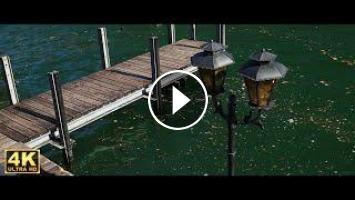Morcote is a municipality in the Swiss canton of Ticino situated about 10 kilometres from Lugano in the district of Lugano on the shore of Lake Lugano.
History
Morcote's lakefront. The town's development and history are connected to the lake
Aerial view from 100 m by Walter Mittelholzer (1929)
Morcote is first mentioned historically in 926 as Murcau, which comes from the Latin Morae caput, meaning head of the hill. In 1353 it was mentioned as Murchoe and again in 1453 as Murchote.
Starting around 1100, Morcote was home to a castle that was built to guard and control commerce on the lake. Until the dam was built in Melide in 1847, Morcote was the largest port on Lake Lugano. Goods from northern Italy were shipped across the lake to the rest of Ticino [The Italian speaking part of Switzerland]. For more info, please visit Wikipedia: https://en.wikipedia.org/wiki/Morcote
Geography
Morcote has an area, (as of the 2004/09 survey) of 2.79 km2 (1.08 sq mi). Of this area, about 2.5% is used for agricultural purposes, while 81.5% is forested and 16.0% is settled (buildings or roads). In the 2004/09 survey a total of 37 ha (91 acres) or about 13.3% of the total area was covered only with buildings, an increase of 5 ha (12 acres) over the 1983 amount. About 0.72% of the total area is recreational space. Of the agricultural land, 2 ha (4.9 acres) is used for orchards and vineyards, 5 ha (12 acres) is fields and grasslands and 3 ha (7.4 acres) consists of alpine grazing areas. Since 1983 the amount of agricultural land has decreased by 5 ha (12 acres). Over the same time period the amount of forested land has increased by 1 ha (2.5 acres). Despite being on the lake, the borders of the municipality do not include any rivers or lakes.
The municipality is located in the Lugano district, between Lake Lugano and Monte Arbostora. It consists of the village of Morcote, the village of Vico until 1803 and between 1803–16, Carabietta.
Heritage sites of national significance
The parish church of Santa Maria del Sasso
The Chapel of S. Antonio Abate with its monumental staircase, the Parish Church of S. Maria del Sasso with Oratory, the Cimitero monumentale (Cemetery) and Scherrer Park are listed as Swiss heritage site of national significance. The entire village of Morcote is part of the Inventory of Swiss Heritage Sites.
Sites
The church of Santa Maria del Sasso was probably built in the 13th century. It was completely rebuilt in 1462 in the style of the Renaissance. In 1758 it was renovated in the baroque style, while in the 18th century a monumental staircase was added to the front of the church. The church tower was built in the Middle Ages and made taller during the 16th century.The church contains several valuable frescos from the 16th and 17th Centuries including one painting that is dated to 1513. The sacramental chapel contains carvings from 1591 and paintings from 1611. In the chapel on the opposite side contains an example of illusionistic architecture painting from the 18th century. Near the church is the Chapel Sant' Antonio do Padova which was built in 1676 with an unusual octagonal floor plan and dome.
Cemetery of Morcote
In 1750 a large cemetery was added near the church. In the terraced cemetery overlooking the lake, many artists are buried, among them Alexander Moissi, actor, Georges Baklanoff, Russian baritone, Georg Kaiser, German author, and Eugen d’Albert, German composer and pianist.
The chapel of Sant' Antonio Abata, consecrated before 1591, was originally a hospice run by the Antonines order of Vienna. The interior houses several frescoes from a 15th-century master artist from Seregno, as well as other newer paintings. [...]
Video:
Clips shot entirely hand-held with my Canon EOS M100 in FHD 1920x1080 59.97fps. Video edited in DaVinci Resolve 16.2.4. All clips corrected as for colors, WB, sharpness, contrast, saturation etc. as well as stabilized in post. Video rendered (up-scaled) in 4K 3840x2160 @60fps with 2.35 cinematic black bars. Video file-size: 6.45GB, average bit rate: 152 Mbps.
Lenses:
Vivitar 24mm f2.8
Nikon E-Series 50mm f1.8
nikon E-Series 100mm f2.8
Variable ND filter / CPL
Music (fully licensed):
“Eyes of Wonder” by Caleb Etheridge
https://app.soundstripe.com/artists/143
Thank you very much to everyone for watching and comment!
Stay connected with me at:
Facebook: http://www.facebook.com/luca.trava1
Instagram: http://www.instagram.com/lb_tra
History
Morcote's lakefront. The town's development and history are connected to the lake
Aerial view from 100 m by Walter Mittelholzer (1929)
Morcote is first mentioned historically in 926 as Murcau, which comes from the Latin Morae caput, meaning head of the hill. In 1353 it was mentioned as Murchoe and again in 1453 as Murchote.
Starting around 1100, Morcote was home to a castle that was built to guard and control commerce on the lake. Until the dam was built in Melide in 1847, Morcote was the largest port on Lake Lugano. Goods from northern Italy were shipped across the lake to the rest of Ticino [The Italian speaking part of Switzerland]. For more info, please visit Wikipedia: https://en.wikipedia.org/wiki/Morcote
Geography
Morcote has an area, (as of the 2004/09 survey) of 2.79 km2 (1.08 sq mi). Of this area, about 2.5% is used for agricultural purposes, while 81.5% is forested and 16.0% is settled (buildings or roads). In the 2004/09 survey a total of 37 ha (91 acres) or about 13.3% of the total area was covered only with buildings, an increase of 5 ha (12 acres) over the 1983 amount. About 0.72% of the total area is recreational space. Of the agricultural land, 2 ha (4.9 acres) is used for orchards and vineyards, 5 ha (12 acres) is fields and grasslands and 3 ha (7.4 acres) consists of alpine grazing areas. Since 1983 the amount of agricultural land has decreased by 5 ha (12 acres). Over the same time period the amount of forested land has increased by 1 ha (2.5 acres). Despite being on the lake, the borders of the municipality do not include any rivers or lakes.
The municipality is located in the Lugano district, between Lake Lugano and Monte Arbostora. It consists of the village of Morcote, the village of Vico until 1803 and between 1803–16, Carabietta.
Heritage sites of national significance
The parish church of Santa Maria del Sasso
The Chapel of S. Antonio Abate with its monumental staircase, the Parish Church of S. Maria del Sasso with Oratory, the Cimitero monumentale (Cemetery) and Scherrer Park are listed as Swiss heritage site of national significance. The entire village of Morcote is part of the Inventory of Swiss Heritage Sites.
Sites
The church of Santa Maria del Sasso was probably built in the 13th century. It was completely rebuilt in 1462 in the style of the Renaissance. In 1758 it was renovated in the baroque style, while in the 18th century a monumental staircase was added to the front of the church. The church tower was built in the Middle Ages and made taller during the 16th century.The church contains several valuable frescos from the 16th and 17th Centuries including one painting that is dated to 1513. The sacramental chapel contains carvings from 1591 and paintings from 1611. In the chapel on the opposite side contains an example of illusionistic architecture painting from the 18th century. Near the church is the Chapel Sant' Antonio do Padova which was built in 1676 with an unusual octagonal floor plan and dome.
Cemetery of Morcote
In 1750 a large cemetery was added near the church. In the terraced cemetery overlooking the lake, many artists are buried, among them Alexander Moissi, actor, Georges Baklanoff, Russian baritone, Georg Kaiser, German author, and Eugen d’Albert, German composer and pianist.
The chapel of Sant' Antonio Abata, consecrated before 1591, was originally a hospice run by the Antonines order of Vienna. The interior houses several frescoes from a 15th-century master artist from Seregno, as well as other newer paintings. [...]
Video:
Clips shot entirely hand-held with my Canon EOS M100 in FHD 1920x1080 59.97fps. Video edited in DaVinci Resolve 16.2.4. All clips corrected as for colors, WB, sharpness, contrast, saturation etc. as well as stabilized in post. Video rendered (up-scaled) in 4K 3840x2160 @60fps with 2.35 cinematic black bars. Video file-size: 6.45GB, average bit rate: 152 Mbps.
Lenses:
Vivitar 24mm f2.8
Nikon E-Series 50mm f1.8
nikon E-Series 100mm f2.8
Variable ND filter / CPL
Music (fully licensed):
“Eyes of Wonder” by Caleb Etheridge
https://app.soundstripe.com/artists/143
Thank you very much to everyone for watching and comment!
Stay connected with me at:
Facebook: http://www.facebook.com/luca.trava1
Instagram: http://www.instagram.com/lb_tra
- Catégories
- E commerce Divers















Commentaires